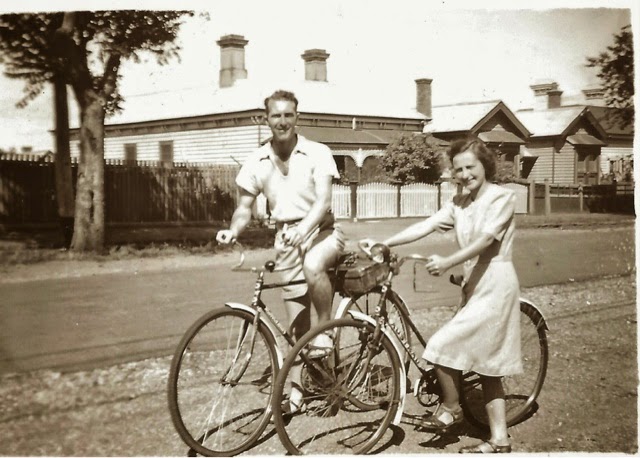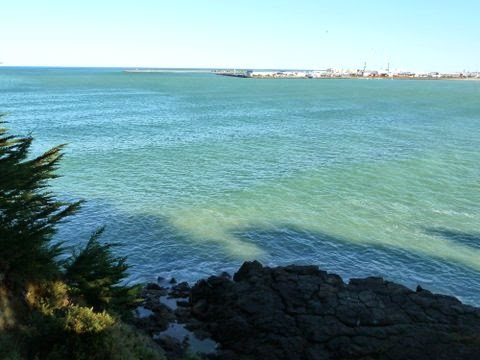The ladies in the Sepia Saturday prompt this week look very stylish. I don't know how they managed to keep their voluminous skirts out of the spokes even assuming that skirt guards were in use in those days! I don't have any old photographs of grandparents or previous generations riding bicycles in my family collection, but I do know my grandmother Mona only learnt to ride in her fifties. I also don't remember seeing either of my parents riding, and if they did, there's no photographic evidence of it, although I have previously shown a photo of my mother's brother Ken riding his bike in Christchurch in the snow in about 1930, which you can see here.. The photo below shows my mother-in-law Mary and her brother-in-law Winton on bikes outside the home of their parents-in-law, in Little Myers St Geelong, in about 1947. They were probably setting off on a ride around Geelong, perhaps including a picnic by the river, presumeably with their respective partners Bob and Jean.
The shot is taken looking cross the street to the houses opposite, next door to Taylors timber yard that was located there. Mary well remembers that loud hooters sounded from the yard signalling early morning starts, lunch and finish times. It's hard to read the brand on Win's bike but I think it could possibly be a Malvern Star, which I find interesting because we now live close to the Melbourne suburb of Malvern, where those bikes were originally manufactured.
According to the local Stonnington History Centre web site, "[t]he first Malvern Star bicycle was made in a shop [at]185 Glenferrie Road, by champion cyclist Thomas Finnigan in 190[2]. World champion cyclist (Sir) Hubert 'Oppy' Opperman joined the business after it was sold to (Sir) Bruce Small in 1920. The partnership of 'Oppy' and Small made Malvern Star a household name and the business grew to become a bicycling empire unequalled in the Southern Hemisphere." There are several photographs on the site on the subject of the Malvern Star, including this one here of Tom Finnigan on his bike, and of course there is more information about the history of the company he founded on Wikipedia.
 |
| Advertisement from the Argus, 21 Oct 1955 |
Above and below are a couple of advertisements for Malvern Star from the Argus newspaper.
 |
| From The Argus, 14 Dec 1940, Malvern Star advertisement, found on Trove web site. |

The place where Malvern Star bikes were first made. Those 3 Rs don't stand for Ride, Ride, Ride, but for Readings, a Melbourne book store which has been there since 1969, Malvern Star has been re-born since then however, and for yet more information and old photographs click here to go to the company web site.
Following on from the second advertisement, here is a photo of yours truly with the Christmas present I received in 1962, which may or may not have been a Malvern Star. I'm sure I wanted one, as that was THE bike to have, but I have a feeling that Dad may have bought mine second hand and done it up for me. I enjoyed riding it to primary and high school. I remember learning to ride in a vacant block near where we lived, with the help of some neighbourhood friends, and once you learn, you never forget how to ride.
 |
| Daughter Claire with her new bike, Xmas 1988 |
We are off to Canberra for the Easter weekend, with our bikes loaded onto the car bike rack. Canberra these days has a very good network or cycle paths, although that wasn't the case when I grew up there.
To read more blogs relating to cycling in parks, mass riding, ladies in long skirts, or other similar subjects, just get 'on yer bike', head over to Sepia Saturday #273 , and have a very happy Easter!
Postscript: just remembered this photo in my mother's collection from her college days in Auckland including a couple of the students' bikes, from a similar time to the first photo here, circa 1946. Good to begin and end in sepia.






%2B-%2BCopy%2B(1).jpg)







































